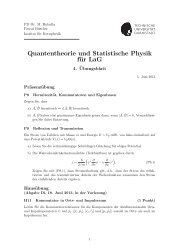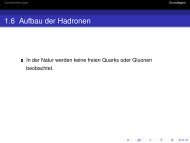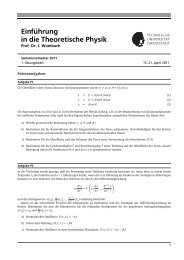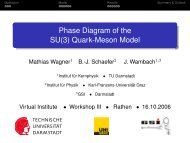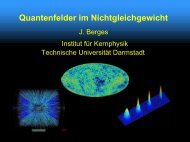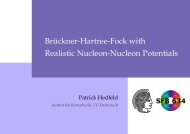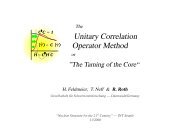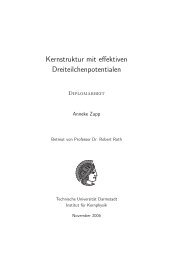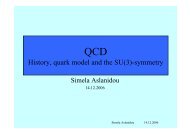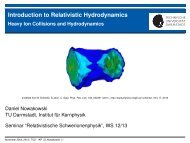Consistent chiral three-nucleon interactions in ... - Theory Center
Consistent chiral three-nucleon interactions in ... - Theory Center
Consistent chiral three-nucleon interactions in ... - Theory Center
You also want an ePaper? Increase the reach of your titles
YUMPU automatically turns print PDFs into web optimized ePapers that Google loves.
SECTION 1<br />
Introduction<br />
From the po<strong>in</strong>t of view of low-energy nuclear structure physics, the atomic nu-<br />
cleus is built of protons and neutrons, the so called <strong>nucleon</strong>s. Quarks and gluons,<br />
which represent the <strong>in</strong>ternal degrees of freedom of the <strong>nucleon</strong>s, are not consid-<br />
ered explicitly. The issue of nuclear structure physics is, on the one hand to make<br />
precise predictions for experimental observables, e.g. b<strong>in</strong>d<strong>in</strong>g and excitation en-<br />
ergies and <strong>nucleon</strong> densities, which can also be used as <strong>in</strong>put for further <strong>in</strong>vesti-<br />
gations, e.g. <strong>in</strong> astrophysics. On the other hand, one is <strong>in</strong>terested <strong>in</strong> a theoretical<br />
framework which can describe the experimental properties of nuclei based on the<br />
fundamental physics of the strong <strong>in</strong>teraction.<br />
In this thesis we pursue the strategy of solv<strong>in</strong>g the time-<strong>in</strong>dependent many-<br />
body Schröd<strong>in</strong>ger equation, which is equivalent to solv<strong>in</strong>g the eigenvalue problem<br />
of the Hamilton operator. While the statement of the task is rather simple, two dif-<br />
ficulties arise when we approach the eigenvalue problem. Firstly, only some basic<br />
symmetry assumptions, e.g. rotational <strong>in</strong>variance, restrict the possible operator<br />
structures <strong>in</strong> the nuclear <strong>in</strong>teraction. Therefore, an appropriate <strong>in</strong>teraction appli-<br />
cable over a wide range of nuclei is still absent. Secondly, solv<strong>in</strong>g the many-body<br />
problem itself is non-trivial, because it will turn out that we have to deal with large<br />
model spaces to get valuable results.<br />
Concern<strong>in</strong>g the nuclear <strong>in</strong>teraction, <strong>in</strong> the 1990s one assumed two-<strong>nucleon</strong> <strong>in</strong>-<br />
teractions and accepted that irreducible <strong><strong>in</strong>teractions</strong> with<strong>in</strong> triples of <strong>nucleon</strong>s<br />
were neglected. Prom<strong>in</strong>ent examples of these potentials are the Argonne-V18 or<br />
CD-Bonn <strong><strong>in</strong>teractions</strong>, that reproduce <strong>nucleon</strong>-<strong>nucleon</strong> scatter<strong>in</strong>g data as well as<br />
deuteron properties but conta<strong>in</strong> lots of phenomenology.<br />
Us<strong>in</strong>g these potentials for the calculation of spectra of various nuclei, one fails<br />
to match experimental results. A well-known example for such failure is the ground<br />
J. Langhammer 1




